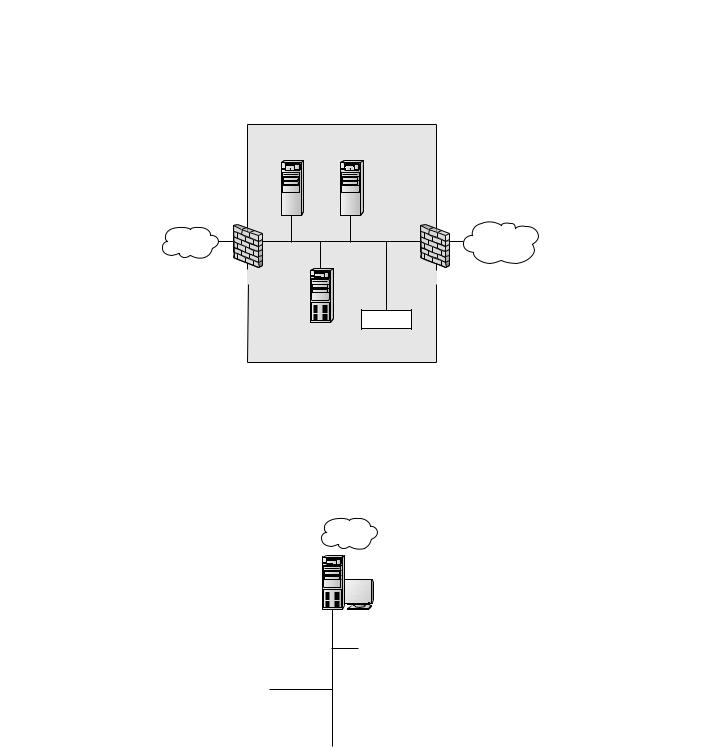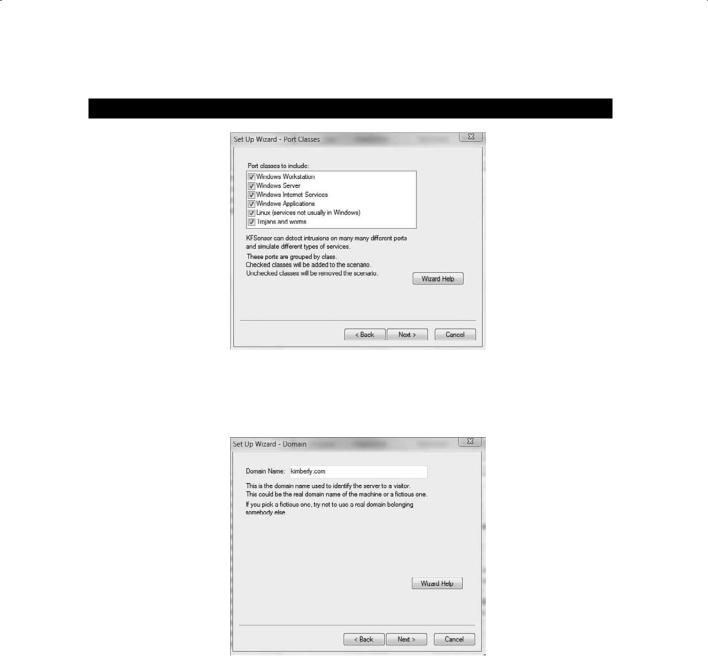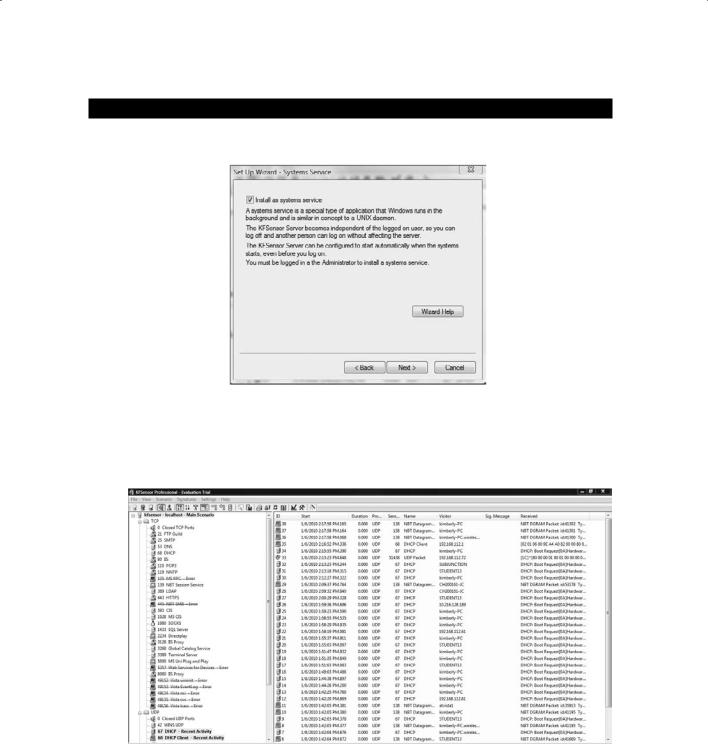
- •Acknowledgments
- •About the Author
- •Contents at a Glance
- •Contents
- •Table of Exercises
- •Introduction
- •Assessment Test
- •Answers to Assessment Test
- •Defining Ethical Hacking
- •How to Be Ethical
- •Keeping It Legal
- •Summary
- •Exam Essentials
- •Review Questions
- •Answers to Review Questions
- •Reconnaissance
- •Information-Gathering Methodology
- •Social Engineering
- •Summary
- •Exam Essentials
- •Review Questions
- •Answers to Review Questions
- •Scanning
- •Enumeration
- •Summary
- •Exam Essentials
- •Review Questions
- •Answers to Review Questions
- •The Simplest Way to Get a Password
- •Types of Passwords
- •Cracking a Password
- •Understanding Keyloggers and Other Spyware Technologies
- •Escalating Privileges
- •Understanding Rootkits
- •Hiding Files
- •Understanding Steganography Technologies
- •Summary
- •Exam Essentials
- •Review Questions
- •Answers to Review Questions
- •Trojans and Backdoors
- •Viruses and Worms
- •Summary
- •Exam Essentials
- •Review Questions
- •Answers to Review Questions
- •How a Sniffer Works
- •Sniffing Countermeasures
- •Bypassing the Limitations of Switches
- •Wireshark Filters
- •Summary
- •Exam Essentials
- •Review Questions
- •Answers to Review Questions
- •Denial of Service
- •Session Hijacking
- •Summary
- •Exam Essentials
- •Review Questions
- •Answers to Review Questions
- •How Web Servers Work
- •Types of Web Server Vulnerabilities
- •Web Application Vulnerabilities
- •Summary
- •Exam Essentials
- •Review Questions
- •Answers to Review Questions
- •SQL Injection
- •Buffer Overflows
- •Summary
- •Exam Essentials
- •Review Questions
- •Answers to Review Questions
- •Wi-Fi and Ethernet
- •Authentication and Cracking Techniques
- •Using Wireless Sniffers to Locate SSIDs
- •MAC Filters and MAC Spoofing
- •Rogue Access Points
- •Wireless Hacking Techniques
- •Securing Wireless Networks
- •Summary
- •Exam Essentials
- •Review Questions
- •Answers to Review Questions
- •Components of Physical Security
- •Understanding Physical Security
- •Physical Site Security Countermeasures
- •What to Do After a Security Breach Occurs
- •Summary
- •Exam Essentials
- •Review Questions
- •Answers to Review Questions
- •Linux Basics
- •Compiling a Linux Kernel
- •GCC Compilation Commands
- •Installing Linux Kernel Modules
- •Linux Hardening Methods
- •Summary
- •Exam Essentials
- •Review Questions
- •Answers to Review Questions
- •Types of IDSs and Evasion Techniques
- •Summary
- •Exam Essentials
- •Review Questions
- •Answers to Review Questions
- •Generating Public and Private Keys
- •Cryptography Algorithms
- •Summary
- •Exam Essentials
- •Review Questions
- •Answers to Review Questions
- •Defining Security Assessments
- •Penetration Testing
- •Pen Test Deliverables
- •Summary
- •Exam Essentials
- •Review Questions
- •Answers to Review Questions
- •Glossary
- •Index

Answers to Review Questions |
299 |
Answers to Review Questions
1.A. LKM stands for Linux Kernel Module.
2.D. g++ source.cpp –o game is the GCC command to create an executable called game from the source file source.
3.A. Use the Cat “All:All”>> /etc/hosts.deny command to deny all users access from the network on a Linux system.
4.C. SUSE, Debian, and Red Hat are all commercial versions of Linux.
5.A. A Linux live CD is a fully functioning operating system that runs from a CD.
6.D. A rootkit can be disguised as an LKM.
7.D. Linux is flexible and can be modified because the source code is openly available.
8.D. Linux should not have unused services running, because each additional service may have potential vulnerabilities.
9.A. An ISO file is used to create a Linux live CD.
10.C. Known good distributions have been reviewed by the Linux community to verify that a Trojan or backdoor does not exist in the source code.
11.D. The command ls -l lists all the information about files such as permissions, owners, size, and last modified date.
12.A. The man command will list help and documentation in Linux.
13.B. The src directory contains the Linux source files.
14.A. The ps command lists all running processes.
15.A. Use the ifconfig command to view the IP address of a network interface. ipconfig and ipconfig/all are Windows commands to view IP address information.
16.C. route displays the routing table. route print is a Windows command to display the routing table. show routes is a command commonly used to view a routing table.
17.A, B. The recommended way to secure the Linux root account is to prevent direct root logins and to restrict the use of su to one group.
18.C, D. Writable system executable directories and writable user home directories should both be checked as they could be used to execute malicious code.
19.B. Use the command Cat “All:All”>> /etc/hosts.deny to harden a Linux system and ensure all users are denied access to certain files from the network.
20.C. User passwords in a Linux system are stored in the shadow file. To harden a system, check the shadow file for null passwords.


Chapter
13
Bypassing Network
Security: Evading
IDSs, Honeypots,
and Firewalls
CEH Exam Objectives Covered in
This Chapter:
ÛÛList the types of intrusion detection systems and evasion techniques
ÛÛList firewall types and honeypot evasion techniques

Intrusion detection systems (IDS), firewalls, and honeypots are all security measures used to ensure a hacker is not able to gain access to a network or target system. An IDS and a
firewall are both essentially packet filtering devices and are used to monitor traffic based on a predefined set of rules. A honeypot is a fake target system used to lure hackers away from the more valuable targets. As with other security mechanisms, IDSs, firewalls, and honeypots are only as good as their design and implementation. It is important to be familiar with how these devices operate and provide security as they are commonly subjects of attack.
Types of IDSs and Evasion Techniques
Intrusion detection systems (IDSs) inspect traffic and look for known signatures of attacks or unusual behavior patterns. A packet sniffer views and monitors traffic and is a built-in component of an IDS. An IDS alerts a command center or system administrator by pager, email, or cell phone when an event appearing on the company’s security event list is triggered. Intrusion prevention systems (IPSs) initiate countermeasures such as blocking traffic when suspected traffic flow is detected. IPSs automate the response to an intrusion attempt and allow you to automate the deny-access capability.
There are two main types of IDS:
Host Based Host-based IDSs (HIDSs) are applications that reside on a single system or host and filter traffic or events based on a known signature list for that specific operating system. HIDSs include Norton Internet Security and Cisco Security Agent (CSA). Many worms and Trojans can turn off an HIDS. HIDSs can also be installed directly on servers to detect attacks against corporate resources and applications.
Network Based Network -based IDSs (NIDSs) are software-based appliances that reside on the network. They’re used solely for intrusion detection purposes to detect all types of malicious network traffic and computer usage that can’t be detected by a conventional
firewall. This includes network attacks against vulnerable services; data attacks on applications; host-based attacks such as privilege escalation, unauthorized logins, and access to sensitive files; and malware. NIDSs are passive systems: the IDS sensor detects a potential security breach, logs the information, and signals an alert on the console.

Types of IDSs and Evasion Techniques |
303 |
The location of a network-based IDS in a network architecture is depicted in Figure 13.1. A network IDS sensor can be located as a first point of detection between the firewall and the Internet or on the semi-private DMZ, detecting attacks on the organization’s servers. Finally, a network IDS can be located on the internal private network, with the corporate servers detecting possible attacks on those servers.
F i g u r e 13 .1 Network -based IDS
Internet
IDS
Semi-Private Network
|
|
|
|
|
|
Firewall |
|
|
|
|
|
|
|
|
|
|
|
|
|
|
|
|
|
|
|
|
|
|
|
|
||
|
|
|
|
|
|
|
|
IDS |
|
|
|
|
|
|
|
|
|
|
|
|
|
|
||||||||||
|
|
|
|
|
|
|
|
|
|
|
|
|
|
|
|
|
|
|
|
|
|
|||||||||||
|
|
|
|
|
|
|
|
|
|
|
|
|
|
|
|
|
|
|
|
|
|
|
|
|
|
|
|
|
|
|
|
|
|
|
|
|
|
|
|
|
|
|
|
|
|
|
|
|
|
|
|
|
|
|
|
|
|
|
|
|
|
|
|
|
|
|
|
|
|
|
|
|
|
|
|
|
|
|
|
|
|
|
|
|
|
|
|
|
|
|
|
|
|
|
|
|
|
|
|
|
|
|
|
|
|
|
|
|
|
|
|
|
|
|
DNS |
|
Web |
|
|
|
|||||||||||
Domain |
|
|
|
|
|
|
|
|
|
|
||||||||||||||||||||||
|
|
|
|
|
|
|
|
|
|
|
|
|
|
Server |
|
Server |
|
|
|
Relay |
||||||||||||
Controller |
|
|
Private Network |
|
|
|
|
|
|
|
|
|
|
|
||||||||||||||||||
|
|
|
|
|
|
|
|
|
|
|
|
|
|
|
|
|
|
|
|
|
|
|
|
|
|
|
||||||
|
|
|
|
|
|
|
|
|
|
|
|
|
|
|
|
|
|
|
|
|
|
|
|
|
|
|
||||||
|
|
|
|
|
|
|
|
|
|
|
|
|
|
|
|
|
|
|
|
|
|
|
|
|
|
|
|
|||||
|
|
|
|
|
|
|
|
|
|
|
|
|
|
|
|
|
|
|
|
|
|
|
|
|
|
|
|
|
|
|
|
|
|
|
IDS |
|
Switch |
|
|
|
|
|
|
|
|
|
|
|
|
|
|
|
|
|
|
|
|
|
|
|
|
|
|
||
Server |
|
|
|
|
|
|
|
|
|
|
|
|
|
|
|
|
|
|
|
|
|
|
|
|
|
|
|
|
|
|||
|
|
|
|
|
|
|
|
|
|
|
|
|
|
|
|
|
|
|
|
|
|
|
|
|
|
|
|
|
|
|
|
|
|
|
|
|
|
|
|
|
|
|
|
|
|
|
|
|
|
|
|
|
|
|
|
|
|
|
|
|
|
|
|
|
|
|
|
|
|
|
|
|
|
|
|
|
|
|
|
|
|
|
|
|
|
|
|
|
|
|
|
|
|
|
|
|
|
|
File |
|
|
|
|
|
|
|
|
|
|
|
|
|
|
|
|
|
|
|
|
|
|
|
|
|
|
|
|
|
|
|
|
Server |
|
|
|
|
|
|
|
|
|
|
|
|
|
|
|
|
|
|
|
|
|
|
|
|
|
|
|
|
|
|
|
|
|
|
|
|
|
|
|
|
|
|
|
|
|
|
|
|
|
|
|
|
|
|
|
|
|
|
|
|
|
|
|
|
|
|
|
|
|
|
|
|
|
|
|
|
|
|
|
|
|
|
|
|
|
|
|
|
|
|
|
|
|
|
|
|
|
|
Database |
|
|
|
|
|
|
|
|
|
|
|
|
|
Client Workstations |
|
|
|
|
|
|
||||||||||||
Server |
|
|
|
|
|
|
|
|
|
|
|
|
|
|
|
|
|
|
|
|||||||||||||
|
|
|
|
|
|
|
|
|
|
|
|
|
|
|
|
|
|
|
|
|
|
|
|
|
|
|
|
|
|
|
|
|
|
|
|
|
|
|
|
|
|
|
|
|
|
|
|
|
|
|
|
|
|
|
|
|
|
|
|
|
|
|
|
|
|
An IDS can perform either signature analysis or anomaly detection to determine if the traffic is a possible attack. Signature detection IDSs match traffic with known signatures and patterns of misuse. A signature is a pattern used to identify either a single packet or a series of packets that, when combined, execute an attack. An IDS that employs anomaly detection looks for intrusion attempts based on a person’s normal business patterns and alerts when there is an anomaly in the behavior of access to systems, files, logins, and so on.
A hacker can evade an IDS by changing the traffic so that it does not match a known signature. This may involve using a different protocol such as UDP instead of TCP or HTTP instead of ICMP to deliver an attack. Additionally, a hacker can break an attack up into several smaller packets to pass through an IDS but, when reassembled at the receiving station, will result in a compromise of the system. This is known as session splicing. Other methods of evading detection involve inserting extra data, obfuscating addresses or data by using encryption, or desynchronizing and taking over a current client’s session.

304 Chapter 13 n Bypassing Network Security: Evading IDSs, Honeypots, and Firewalls
Hacking Tool
ADMmutate takes an attack script and creates a different—but functionally equivalent— script to perform the attack. The new script isn’t in the database of known attack signatures and therefore can bypass the IDS.
Understanding Snort Rules and Output
For the CEH exam, you should be familiar with Snort rules and output. You may need to read a Snort rule or output and answer a question pertaining to what the rule is doing or what type of attack is indicated by the output.
Snort is a real-time packet sniffer, HIDS, and traffic-logging tool deployed on Linux and Windows systems. Snort can analyze protocols, perform content searching/matching, and detect a variety of attacks and probes, such as buffer overflows, stealth port scans, CGI attacks, SMB probes, OS fingerprinting attempts, and much more. You can configure Snort and the IDS rules in the snort.conf file. The command to install and run Snort is:
snort –l c:\snort\log –c C:\snort\etc\snort.conf –A console
Snort consists of two major components:
Snort Engine An IDS detection engine that utilizes a modular plug-in architecture Snort Rules A flexible rule language to describe traffic to be collected
The Snort Engine is distributed both as source code and binaries for popular Linux distributions and Windows. It’s important to note that the Snort Engine and Snort rules are distributed separately. The Snort IDS Engine and rules can be downloaded from snort.org. The installation methods and software dependencies vary by OS, so this chapter does not include a lab on installing Snort. Detailed installation instructions can be found at snort.org.
Configuring Snort
Snort has one configuration file: snort.conf. It usually resides in /etc/snort. The file contains variables that need to be modified for your specific installation and customized to the events you want to alert on. The file variables are organized in the following sections:
NN Network variables NN Preprocessors
NN Postprocessors NN Rules
The snort.conf file network variables that need to be customized to your network are listed in Table 13.1.

|
Types of IDSs and Evasion Techniques |
305 |
Ta b l e 13 .1 Snort |
variables |
|
|
|
|
Variable |
Meaning |
|
|
|
|
HOME_NET |
Local IP address space |
|
EXTERNAL_NET |
External IP address space |
|
SMTP |
Your SMTP servers |
|
HTTP_SERVERS |
Your web servers |
|
SQL_SERVERS |
Your SQL Servers |
|
DNS_SERVERS |
Your DNS servers |
|
RULE_PATH |
The directory that contains your rule files |
|
|
|
|
Here is a sample Snort configuration file using the 192.168.1.0 network as the home network:
var HOME_NET 192.168.1.0/24 var EXTERNAL_NET any
var SMTP $HOME_NET
var HTTP_SERVERS $HOME_NET var SQL_SERVERS $HOME_NET var DNS_SERVERS $HOME_NET
var RULE_PATH /etc/snort/rules
The following are the rule locations identified in the config file:
include $RULE_PATH/exploit.rules include $RULE_PATH/scan.rules include $RULE_PATH/ftp.rules include $RULE_PATH/telnet.rules include $RULE_PATH/smtp.rules include $RULE_PATH/rpc.rules include $RULE_PATH/dos.rules include $RULE_PATH/ddos.rules include $RULE_PATH/dns.rules include $RULE_PATH/web-cgi.rules
include $RULE_PATH/web-coldfusion.rules include $RULE_PATH/web-iis.rules

306 Chapter 13 n Bypassing Network Security: Evading IDSs, Honeypots, and Firewalls
include $RULE_PATH/web-frontpage.rules include $RULE_PATH/web-misc.rules include $RULE_PATH/web-attacks.rules include $RULE_PATH/sql.rules
include $RULE_PATH/netbios.rules include $RULE_PATH/misc.rules
Snort Rules
Snort rules are used to generate alerts based on the traffic that is viewed by the IDS processing engine.
All rules have a rule header composed of the following fields:
NN <rule action>
NN <protocol>
NN <src address & port>
NN <dest address & port>
Here’s an example of a Snort rule:
alert tcp $EXTERNAL_NET any -> $HOME_NET 23
This rule says to generate an alert (and a log message) for any TCP packet coming from an external address space (and any port) destined to the local address space (and port 23).
The Snort rule header is followed by rule options, which are a delimited list of features to use in Snort. Here are some rule options and explanations. The line
msg:”TELNET SGI telnetd format bug”
specifies to the logging and alerting engines what message to print. The line
flags: A+
matches the TCP ACK flag (plus any other set flag). The line
content: “bin/sh”
matches the given string in the packet’s payload. The line
classtype:attempted-admin
associates a high priority to this alert by giving it an attack class of attempted-admin (attempted administrator privilege gain).

Types of IDSs and Evasion Techniques |
307 |
Snort Output
For the CEH exam, it is important to understand a Snort output report. Here is an example of a Snort alert. First, here is the timestamp:
04/21-19:26:37.353790
These are the source and destination MAC addresses:
0:8:2:FB:36:C6 -> 0:6:5B:57:A6:3F
The type of Ethernet frame (0x800 means Ethernet) and the length are next:
type:0x800 len:0x3C
This line specifies the source IP 202.185.44.43 to the destination IP 202.185.44.28 and source port 445 and destination port 2202:
202.185.44.43:445 -> 202.185.44.28:2202
This line states that the protocol is TCP and the Time To Live (TTL) is 128:
TCP TTL:128
Next is the type of service, the ID, the IP length, and the datagram length:
TOS:0x0 ID:17467 IpLen:20 DgmLen:41 DF
The ***A**** means the ACK flag is on, so the packet is an acknowledgment of a previous packet:
***A****
In this line, Seq is the sequence number, and Ack is the numbered response to the previous packet:
Seq: 0x9D08DD67 Ack: 0x83EB1E02
Finally, in the following line Win is the window size and the TCP length is 2000:
Win: 0x3FE1 TcpLen: 2000
In many cases, reading and interpreting Snort output reports on the CEH exam is just a matter of knowing the TCP flags and TCP well-known port numbers.

308 Chapter 13 n Bypassing Network Security: Evading IDSs, Honeypots, and Firewalls
Firewall Types and
Honeypot Evasion Techniques
A firewall is a software program or hardware appliance that allows or denies access to a network and follows rules set by an administrator to direct where packets are allowed to go on the network. A perimeter hardware firewall appliance (Figure 13.2) is set up either at the network edge where a trusted network connects to an untrusted network, such as the Internet, or between networks. A software firewall protects a personal computer, a system, or a host from unwanted or malicious packets entering the network interface card (NIC) from the network.
F i g u r e 13 . 2 Perimeter hardware firewall
Internet


 Firewall
Firewall
Server/PC Server/PC Server/PC Server/PC
A honeypot (Figure 13.3) is a decoy box residing inside your network demilitarized zone (DMZ), set up by a security professional to trap or aid in locating hackers, or to draw them away from the real target system.

Firewall Types and Honeypot Evasion Techniques |
309 |
F i g u r e 13 . 3 Honeypot Location
|
Web |
|
DNS |
||||||||||||
Server |
Server |
||||||||||||||
|
|
|
|
|
|
|
|
|
|
|
|
|
|
|
|
|
|
|
|
|
|
|
|
|
|
|
|
|
|
|
|
|
|
|
|
|
|
|
|
|
|
|
|
|
|
|
|
Internet |
Operational |
|
Network |
||
|
||
Firewall |
Firewall |
Honeypot
FTP
Server
The honeypot is a decoy system that a malicious attacker might try to attack; software on the system can log information about the attacker such as the IP address. This information can be used to try to locate the attacker either during or after the attack. The best location for a honeypot is in front of the firewall on the DMZ, making it attractive to hackers. A honeypot with a static address is designed to look like a real production server (see Figure 13.4). Exercise 13.1 walks you through installing and using a honeypot.
F i gu r e 13 . 4 Honeypot
|
Internet |
|
|
Firewall |
|
|
Internal |
|
Redirected |
Network A |
|
Honeypot |
SCANS |
|
Farm |
SCANS |
Attacker |
|
||
Redirected |
Internal |
|
|
Network B |
|

310 Chapter 13 n Bypassing Network Security: Evading IDSs, Honeypots, and Firewalls
Finding a Honeypot
I was performing a wireless network security audit for a large corporation a few years ago. I drove around the corporate campus scanning for open access points (APs), and I was a bit surprised at how many open unsecured APs could be seen by my wireless scanning sniffer. I found over 30 APs to which I could connect and gain network access.
Of course, the next step after connecting to the APs was to scan the network. So, as part of the security audit, I connected from outside the building and ran a port scan against the entire network range; I found several systems with open ports. There was a mail server and a couple of web servers, as well as a Domain Controller that was not totally patched. As per the scope of the audit, I was just to report the vulnerabilities I found and not attempt to exploit the services I found running on the systems. I was surprised that such a large organization would have vulnerabilities so easily found on the open wireless network. I documented all the target systems and the vulnerable ports and services in my security auditing report.
When I presented my report to the customer the following day, the IT manager simply said, “Good, you found our honeynet, now go find the real systems.” They had taken all the rogue APs discovered on the network and shunted them to a separate VLAN. Then on the shunted VLAN they had created fake systems, or honeypots, to attract potential hackers. These honeypots can keep a hacker busy trying to attack the honeypot system with no real data while the real services are untouched.
E x e r c i s e 13 .1
Installing and Using KFSensor as a Honeypot
1.Download and install a trial version of KFSensor from www.keyfocus.net.
2.Open and run KFSensor. A pop-up window will appear to start the configuration wizard. Click Next to continue.

Firewall Types and Honeypot Evasion Techniques |
311 |
E x e r c i s e 13 .1 ( c o n t i n u e d )
3.Click Next to select all ports.
4.Type your name.com (or another domain name of your choosing) in the Domain Name field and click Next.

312 Chapter 13 n Bypassing Network Security: Evading IDSs, Honeypots, and Firewalls
E x e r c i s e 13 .1 ( c o n t i n u e d )
5.Type your email address in the Send To and Send From fields to receive email alerts from KFSensor.
6.From the Port Activity drop-down, select 8 hours. Choose Enable Packet Dump Files from the Network Protocol Analyzer drop-down. Other options can remain at their defaults.

Firewall Types and Honeypot Evasion Techniques |
313 |
E x e r c i s e 13 .1 ( c o n t i n u e d )
7.Click Next to accept the default to install as a system service.
8.Click Finish to complete the wizard configuration.
9.The Main scenario for KFSensor should appear on the left. You may receive a message indicating that some of the ports have been disabled because they are in use by the system services; the strikeout text indicates the ports are not available in KFSensor.
Perform a port scan against the system running KFSensor to identify the services.

314 Chapter 13 n Bypassing Network Security: Evading IDSs, Honeypots, and Firewalls
E x e r c i s e 13 .1 ( c o n t i n u e d )
10.Attempt to connect to a service running on the KFSensor system.
11.View the visitor to the KFSensor Honeypot by clicking the View menu and choosing Visitors.
12.Click the IP address of a visitor to view the connections.
13.KFSensor will continue to run even when the program is closed. To stop the servers completely, right-click the KFSensor icon in the system tray and choose Stop Server.
The easiest way to bypass a firewall is to compromise a system on the trusted or internal side of the firewall. The compromised system can then connect through the firewall, from the trusted to the untrusted side, to the hacker’s system. A common method of doing this is to make the compromised system connect to the hacker with destination port 80, which looks just like a web client connecting to a web server through the firewall. This is referred to as a reverse WWW shell.
This attack works because most firewalls permit outgoing connections to be made to port 80 by default.
Using a tunnel to send HTTP traffic, the hacker bypasses the firewall and makes the attack look innocuous to the firewall; such attacks are virtually untraceable by system administrators. Hacking programs can create covert channels, which let the attack traffic travel down an allowed path such as an Internet Control Message Protocol (ICMP) ping request or reply. Another method of utilizing a covert channel tunnels the attack traffic as a TCP acknowledgment.
To evade the trap set by a honeypot, a hacker can run anti-honeypot software, which tries to determine whether a honeypot is running on the target system and warn the hacker

Firewall Types and Honeypot Evasion Techniques |
315 |
about it. In this way, a hacker can attempt to evade detection by not attacking a honeypot. Most anti-honeypot software checks the software running on the system against a known list of honeypots such as honeyd.
Hacking Tools
007 Shell is a shell-tunneling program that lets a hacker use a covert channel for the attack and thus bypass firewall rules.
ICMP Shell is a program similar to telnet that a hacker uses to make a connection to a target system using just ICMP commands, which are usually allowed through a firewall.
AckCmd is a client/server program that communicates using only TCP ACK packets, which can usually pass through a firewall.
Covert_TCP is a program that a hacker uses to send a file through a firewall one byte at a time by hiding the data in the IP header.
Send-Safe Honeypot Hunter is a honeypot-detection tool that checks against a proxy server for honeypots.
Countermeasures
Specter is a honeypot system that can automatically capture information about a hacker’s machine while they’re attacking the system.
Honeyd is an open source honeypot that creates virtual hosts on a network that is then targeted by hackers.
KFSensor is a host-based IDS that acts as a honeypot and can simulate virtual services and Trojan installations.
Sobek is a data-capturing honeypot tool that captures an attacker’s keystrokes.
The Nessus vulnerability scanner (www.nessus.org) can also be used to detect honeypots.
